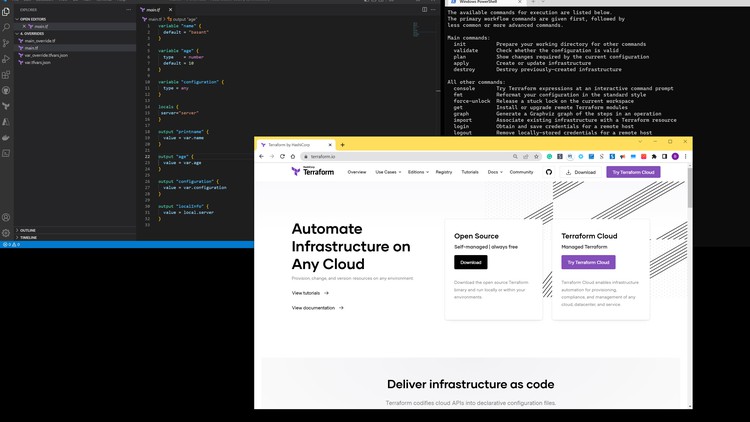
Practice question set help you to gaining the official certification.
What you will learn
Preparation for the Certification Exams
Terraform Practice Exam
Students aiming to pass the HashiCorp Certified
DevOps Engineers looking to automate infrastructure deployment
Description
HashiCorp Associate Certification exams consist of multiple choice, multiple answer, true/false, and text match question types. The questions to introduce you to the question format you will encounter on the exam.
- True or False
True or false questions present you with a statement and ask you to choose whether it is true or false.
- Multiple Choice
Multiple answer questions ask you to select multiple correct answers from a list. The question indicates you how many answers you must choose.
- Multiple Answer
Multiple answer questions ask you to select multiple correct answers from a list. The question indicates you how many answers you must choose.
- Text Match
Text match questions present you with a statement and ask you to fill in the blank by typing an answer into a text box. The exam will accept common typos and variations on the correct answer. Text match is not case sensitive.
HashiCorp Certified: Terraform Associate practice test up to date with the current exam Curriculum 2022.
The Terraform Associate certification (002) is for Cloud Engineers specializing in operations, IT, or development who know the basic concepts and skills associated with open source HashiCorp Terraform. Candidates will be best prepared for this exam if they have professional experience using Terraform in production, but performing the exam objectives in a personal demo environment may also be sufficient.
- Understand Infrastructure as Code (IaC) concepts
- Explain what IaC is
- Describe advantages of IaC patterns
- Understand Terraform’s purpose (vs other IaC)
- Explain multi-cloud and provider-agnostic benefits
- Explain the benefits of state
- Understand Terraform basics
- Handle Terraform and provider installation and versioning
- Describe plug-in based architecture
- Demonstrate using multiple providers
- Describe how Terraform finds and fetches providers
- Explain when to use and not use provisioners and when to use local-exec or remote-exec
- Use the Terraform CLI (outside of core workflow)
- Given a scenario: choose when to use terraform fmt to format code
- Given a scenario: choose when to use terraform taint to taint Terraform resources
- Given a scenario: choose when to use terraform import to import existing infrastructure into your Terraform state
- Given a scenario: choose when to use terraform workspace to create workspaces
- Given a scenario: choose when to use terraform state to view Terraform state
- Given a scenario: choose when to enable verbose logging and what the outcome/value is
- Interact with Terraform modules
- Contrast module source options
- Interact with module inputs and outputs
- Describe variable scope within modules/child modules
- Discover modules from the public Terraform Module Registry
- Defining module version
- Navigate Terraform workflow
- Describe Terraform workflow ( Write -> Plan -> Create )
- Initialize a Terraform working directory (terraform init)
- Validate a Terraform configuration (terraform validate)
- Generate and review an execution plan for Terraform (terraform plan)
- Execute changes to infrastructure with Terraform (terraform apply)
- Destroy Terraform managed infrastructure (terraform destroy)
- Implement and maintain state
- Describe default local backend
- Outline state locking
- Handle backend authentication methods
- Describe remote state storage mechanisms and supported standard backends
- Describe effect of Terraform refresh on state
- Read, generate, and modify configuration
- Demonstrate use of variables and outputs
- Describe secure secret injection best practice
- Understand the use of collection and structural types
- Create and differentiate resource and data configuration
- Use resource addressing and resource parameters to connect resources together
- Use Terraform built-in functions to write configuration
- Configure resource using a dynamic block
- Describe built-in dependency management (order of execution based)
- Understand Terraform Cloud and Enterprise capabilities
- Describe the benefits of Sentinel, registry, and workspaces
- Describe the benefits of Sentinel, registry, and workspaces
- Summarize features of Terraform Cloud